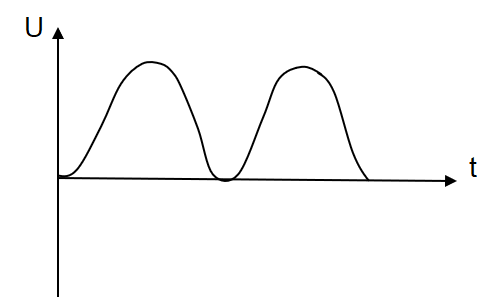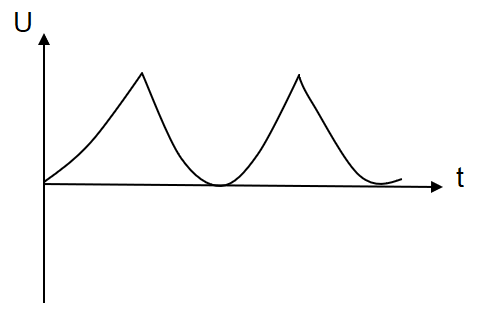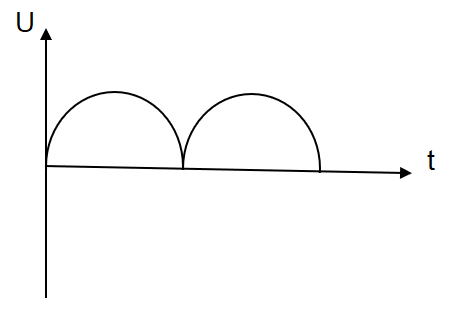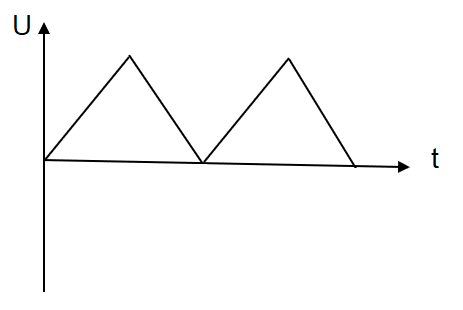
As a body performs SHM, its potential energy U varies with time t as indicated in
A. 
B. 
C. 
D. 
Answer
220.2k+ views
Hint: Simple harmonic motion is defined as a periodic motion in which the acceleration(a) of a body is directly proportional to its displacement (x)and is directed towards the equilibrium position or mean position. The relation between the potential energy(U), kinetic energy(K), and time(t) in Simple Harmonic Motion or SHM at t = 0 can be obtained in a graph.
Formula used:
The potential energy (U) of a body performs SHM is given as:
\[U = \dfrac{1}{2}k{x^2}\] or \[U = \dfrac{1}{2}m{\omega ^2}{A^2}{\sin ^2}\omega t\]
Where k is force constant
x is the displacement
m is mass of the particle
\[\omega \] is angular frequency
A is amplitude
t is time taken
Complete step by step solution:
As we know that potential energy U of a body performs SHM is,
\[U = \dfrac{1}{2}k{x^2}\]
As a body performs SHM, so we can write
\[x = A{\rm{ }}\sin \omega t\]
Now using this value in above equation, we have
\[U = \dfrac{1}{2}k{A^2}{\sin ^2}\omega t\]
Where \[\omega = \sqrt {\dfrac{k}{m}} \]
\[{\rm{ k = m}}{\omega ^2}\]
By using this value of k in above, we get
\[U = \dfrac{1}{2}m{\omega ^2}{A^2}{\sin ^2}\omega t\]
So, by this equation we can see that at any time, t=0 then Potential energy will also become U=0. For any value of angle, it will always be positive. Hence a positive graph will be formed.
Hence option A is the correct answer.
Note: Simple Harmonic Motion or SHM can be defined as the motion in which the restoring force(F) is directly proportional to the displacement(x) of the body from its equilibrium or mean position. It is a special case of an oscillation in which the motion takes place in a straight line between the two extreme positions.
Formula used:
The potential energy (U) of a body performs SHM is given as:
\[U = \dfrac{1}{2}k{x^2}\] or \[U = \dfrac{1}{2}m{\omega ^2}{A^2}{\sin ^2}\omega t\]
Where k is force constant
x is the displacement
m is mass of the particle
\[\omega \] is angular frequency
A is amplitude
t is time taken
Complete step by step solution:
As we know that potential energy U of a body performs SHM is,
\[U = \dfrac{1}{2}k{x^2}\]
As a body performs SHM, so we can write
\[x = A{\rm{ }}\sin \omega t\]
Now using this value in above equation, we have
\[U = \dfrac{1}{2}k{A^2}{\sin ^2}\omega t\]
Where \[\omega = \sqrt {\dfrac{k}{m}} \]
\[{\rm{ k = m}}{\omega ^2}\]
By using this value of k in above, we get
\[U = \dfrac{1}{2}m{\omega ^2}{A^2}{\sin ^2}\omega t\]
So, by this equation we can see that at any time, t=0 then Potential energy will also become U=0. For any value of angle, it will always be positive. Hence a positive graph will be formed.
Hence option A is the correct answer.
Note: Simple Harmonic Motion or SHM can be defined as the motion in which the restoring force(F) is directly proportional to the displacement(x) of the body from its equilibrium or mean position. It is a special case of an oscillation in which the motion takes place in a straight line between the two extreme positions.
Recently Updated Pages
Electricity and Magnetism Explained: Key Concepts & Applications

JEE Energetics Important Concepts and Tips for Exam Preparation

JEE Isolation, Preparation and Properties of Non-metals Important Concepts and Tips for Exam Preparation

JEE Main 2021 July 25 Shift 1 Question Paper with Answer Key

JEE Main 2021 July 22 Shift 2 Question Paper with Answer Key

States of Matter Chapter For JEE Main Chemistry

Trending doubts
JEE Main 2026: Application Form Open, Exam Dates, Syllabus, Eligibility & Question Papers

Understanding Uniform Acceleration in Physics

Derivation of Equation of Trajectory Explained for Students

Hybridisation in Chemistry – Concept, Types & Applications

Understanding the Angle of Deviation in a Prism

How to Convert a Galvanometer into an Ammeter or Voltmeter

Other Pages
Thermodynamics Class 11 Physics Chapter 11 CBSE Notes - 2025-26

JEE Advanced Marks vs Ranks 2025: Understanding Category-wise Qualifying Marks and Previous Year Cut-offs

Units And Measurements Class 11 Physics Chapter 1 CBSE Notes - 2025-26

NCERT Solutions For Class 11 Physics Chapter 8 Mechanical Properties Of Solids

Motion in a Straight Line Class 11 Physics Chapter 2 CBSE Notes - 2025-26

NCERT Solutions for Class 11 Physics Chapter 7 Gravitation 2025-26




